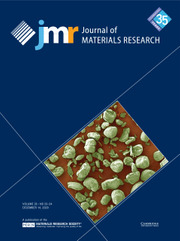Crossref Citations
This article has been cited by the following publications. This list is generated based on data provided by
Crossref.
Cho, Chae-Woong
Kim, Sang-Kyun
Paik, Ungyu
Park, Jea-Gun
and
Sigmund, Wolfgang M.
2006.
Atomic force microscopy study of the role of molecular weight of poly(acrylic acid) in chemical mechanical planarization for shallow trench isolation.
Journal of Materials Research,
Vol. 21,
Issue. 2,
p.
473.
Lee, Seung-Mi
Lee, Sangkyu
Cho, Chae-Woong
Paik, Ungyu
Kim, Dae-Hwan
Na, Eun-Sang
and
Park, Jea-Gun
2006.
Surface modification of BaTiO3 with yttrium, and dissolution and adsorption/precipitation behaviors of BaTiO3.
Journal of Electroceramics,
Vol. 17,
Issue. 2-4,
p.
355.
Kang, Hyun-Goo
Park, Hyung-Soon
Paik, Ungyu
and
Park, Jea-Gun
2007.
Effects of abrasive particle size and molecular weight of poly(acrylic acid) in ceria slurry on removal selectivity of SiO2/Si3N4 films in shallow trench isolation chemical mechanical planarization.
Journal of Materials Research,
Vol. 22,
Issue. 3,
p.
777.
Ren, Zhaohui
Xu, Gang
Wei, Xiao
Liu, Yong
Shen, Ge
and
Han, Gaorong
2007.
Shape Evolution of Pb (Zr,Ti)O3 Nanocrystals Under Hydrothermal Conditions.
Journal of the American Ceramic Society,
Vol. 90,
Issue. 8,
p.
2645.
Iijima, Motoyuki
Sato, Nobuhiro
Tsukada, Mayumi
and
Kamiya, Hidehiro
2007.
Dispersion Behavior of Barium Titanate Nanoparticles Prepared by Using Various Polycarboxylic Dispersants.
Journal of the American Ceramic Society,
Vol. 90,
Issue. 9,
p.
2741.
2009.
Nanoparticle Engineering for Chemical-Mechanical Planarization.
p.
192.
Şakar-Deliormanlı, Aylin
Çelik, Erdal
and
Polat, Mehmet
2009.
Influence of Dispersing Agents on the Solubility of Perovskites in Water.
Journal of Dispersion Science and Technology,
Vol. 30,
Issue. 5,
p.
704.
Hu, Yong‐Ming
Gu, Hao‐Shuang
Zhou, Di
Wang, Zhao
Chan, Helen Lai‐Wa
and
Wang, Yu
2010.
Orientation‐Control Synthesis of KTa0.25Nb0.75O3 Nanorods.
Journal of the American Ceramic Society,
Vol. 93,
Issue. 3,
p.
609.
Galassi, Carmen
2011.
Multifunctional Polycrystalline Ferroelectric Materials.
Vol. 140,
Issue. ,
p.
1.
Joshi, Girish M.
Khatake, S.M.
Kaleemulla, S.
Rao, N. Madhusudhana
and
Cuberes, Teresa
2011.
Effect of dopant and DC bias potential on dielectric properties of polyvinyl alcohol (PVA)/PbTiO3 - composite films.
Current Applied Physics,
Vol. 11,
Issue. 6,
p.
1322.
Glass, Christian
Ahmed, Waqqar
and
van Ruitenbeek, Jan
2014.
Tuning the morphology of lead zirconate titanate (PZT) nanostructures.
Materials Letters,
Vol. 125,
Issue. ,
p.
71.
Peng, Q. X.
Luo, W. B.
Wu, C. G.
Sun, X. Y.
Li, P.
and
Chen, X. Y.
2014.
The fabrication and pyroelectric properties of single crystalline PZT nanorod synthesized by hydrothermal reaction.
Journal of Materials Science: Materials in Electronics,
Vol. 25,
Issue. 4,
p.
1627.
Araújo, V.D.
Tranquilin, R.L.
Motta, F.V.
Paskocimas, C.A.
Bernardi, M.I.B.
Cavalcante, L.S.
Andres, J.
Longo, E.
and
Bomio, M.R.D.
2014.
Effect of polyvinyl alcohol on the shape, photoluminescence and photocatalytic properties of PbMoO4 microcrystals.
Materials Science in Semiconductor Processing,
Vol. 26,
Issue. ,
p.
425.
Darabi, Mohammad Ali
Khosrozadeh, Ali
Wang, Ying
Ashammakhi, Nureddin
Alem, Halima
Erdem, Ahmet
Chang, Qiang
Xu, Kaige
Liu, Yuqing
Luo, Gaoxing
Khademhosseini, Ali
and
Xing, Malcolm
2020.
An Alkaline Based Method for Generating Crystalline, Strong, and Shape Memory Polyvinyl Alcohol Biomaterials.
Advanced Science,
Vol. 7,
Issue. 21,
Jo, Nak-Beom
Baek, Jin-Seok
and
Kim, Eung-Soo
2021.
The Effect of PVA Binder Solvent Composition on the Microstructure and Electrical Properties of 0.98BaTiO3-0.02(Ba0.5Ca0.5)SiO3 Doped with Dy2O3.
Processes,
Vol. 9,
Issue. 11,
p.
2067.
Chun, Hee-Joon
Jeon, Ji-Eun
and
Park, Seong-Chan
2023.
Facet-Dependent Ba Dissolution of Tetragonal BaTiO3 Single Crystal Surfaces.
The Journal of Physical Chemistry C,
Vol. 127,
Issue. 4,
p.
1848.
Razouq, Hasan
Neuhauser, Kerstin
Zickler, Gregor
Berger, Thomas
and
Diwald, Oliver
2023.
Water-Mediated Conversion of BaTiO3 Nanoparticles into BaCO3 Nanorods in Electrospun Polymer Fibers: Implications for Carbon Capture Applications.
ACS Applied Nano Materials,
Vol. 6,
Issue. 21,
p.
19887.


